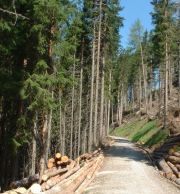In an age where the UK economy is dominated by financial services, there remains a range of overlooked markets such as fishing and even manufacturing.
The logging and forestry sector is also a large but understated industry, which is involved in a range of activities such as growing standing timber in natural (and planted) forests and producing timer for various manufacturing and construction industries.
The latest numbers from the UK's logging and forestry industry
The UK was classed as the second largest net importer of forest products through 2020, with only China ahead of the region.
In terms of primary wood processing alone within this marketplace, the gross value added (GVA) in the UK peaked at £1.53 billion in 2020, while the GVA in foresting was £0.74 billion.
Of course, these figures should come as no surprise, with some 88% of the UK not yet built on and the region's total area of woodland estimated to be 3.24 million hectares as of March 31st, 2022.
What's more, approximately 14 thousand hectares of new woodland were created in the UK during 2020/21, with this helping to sustain a traditional industry that employed more than 30,000 people combined through 2020.
19,000 of this total number worked in forestry, with a further eight thousand employed in sawmilling and five thousand active in panel mills nationwide.
Industry projections and the uses of timber
In the coming years, industry revenue is forecast to grow, in line with increased demand from the developing world.
This increase in demand, which should continue to outstrip supply, will trigger a marked rise in timber prices, which in turn will invite new companies into the marketplace across an array of different industries.
It should also be noted that so-called "natural capital" is increasing in interest in the UK, particularly as utility companies look to invest in large scale tree planting on their various estates to help improve water quality and offset some of their considerable carbon emissions.
Make no mistake; woodland area is now being used for carbon sequestrations, with some 8,300 hectares of relevant UK woodland projected to sequester 3.4 million tonnes of carbon dioxide over the course of their lifetime.
In terms of growing demand, it should be noted that timber has an endless stream of uses in 2022. Remember that the forestry industry also produces treated timber, which can be utilised across a broad range of building and construction projects.
In addition to all this, the regular use and growing of wood has immense environmental benefits, especially in terms of removing carbon dioxide from the air and tackling the carbon crisis as it unfolds across the globe.





